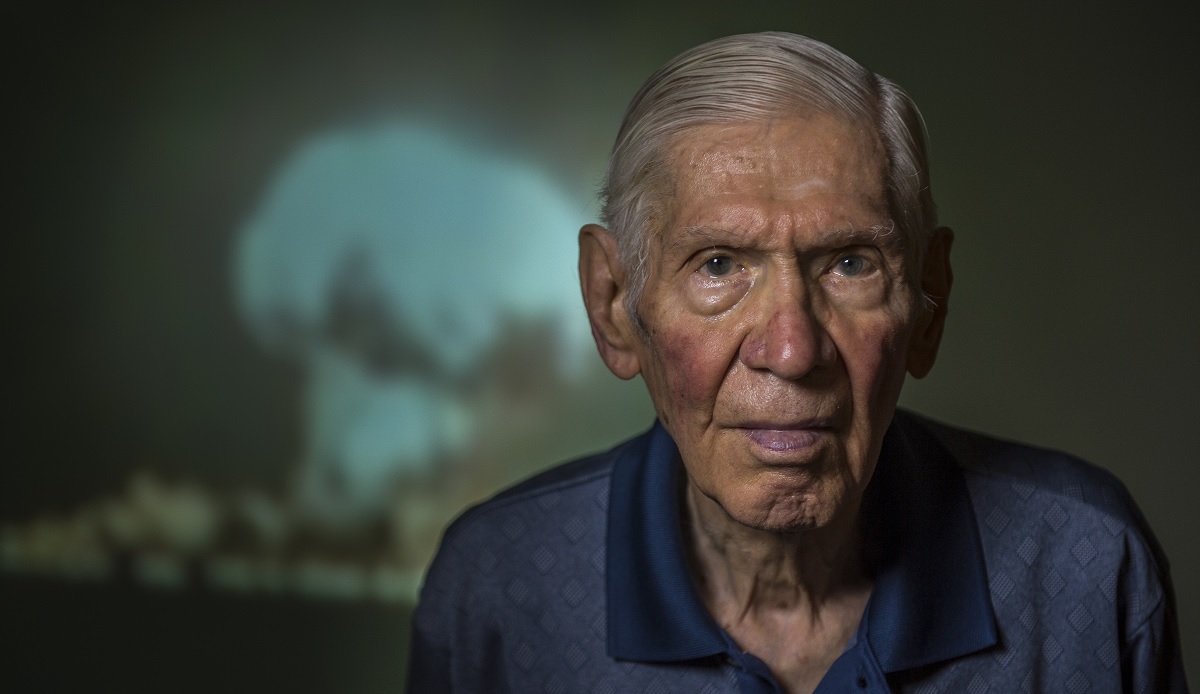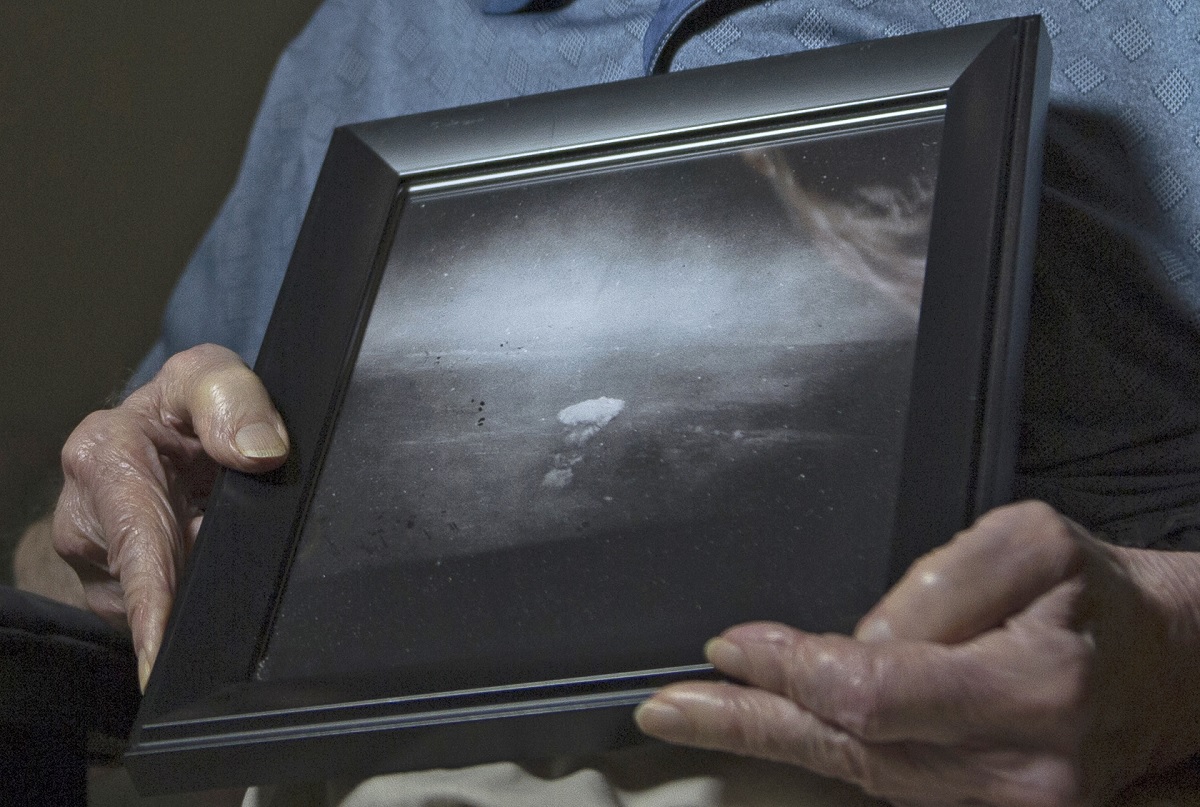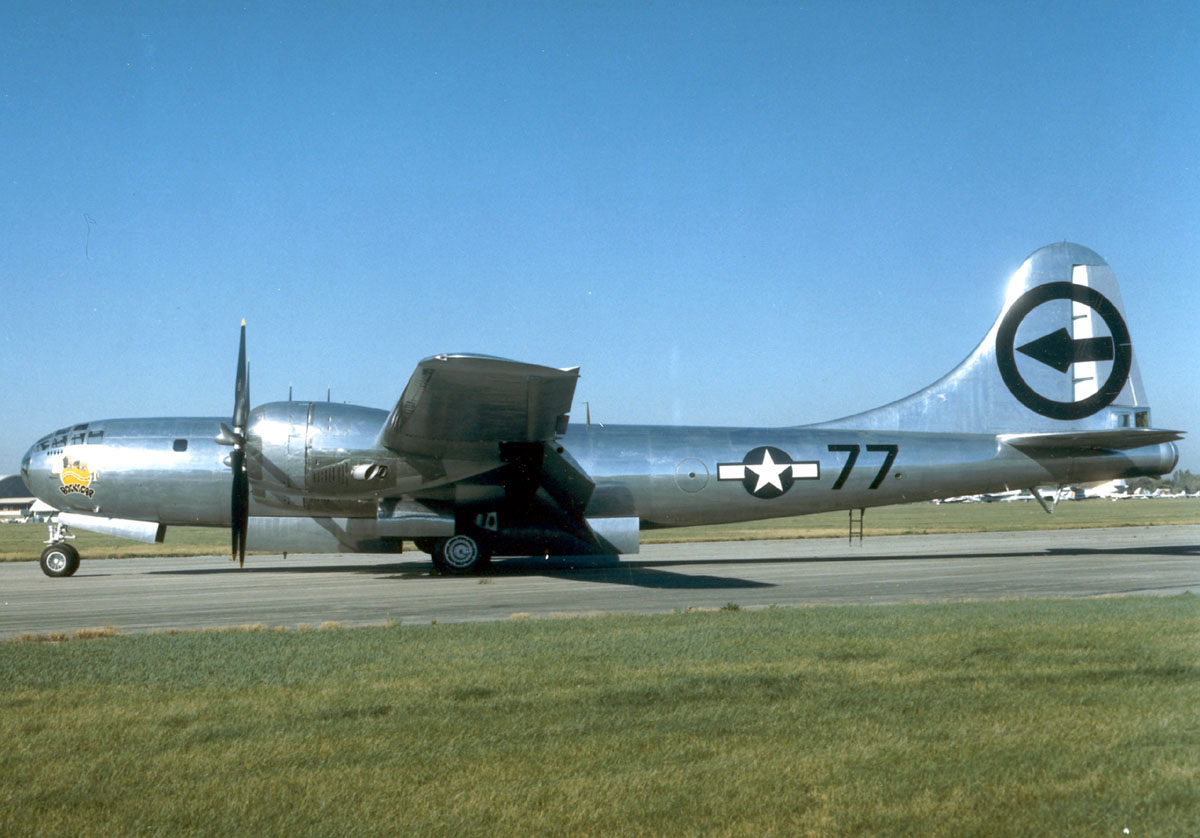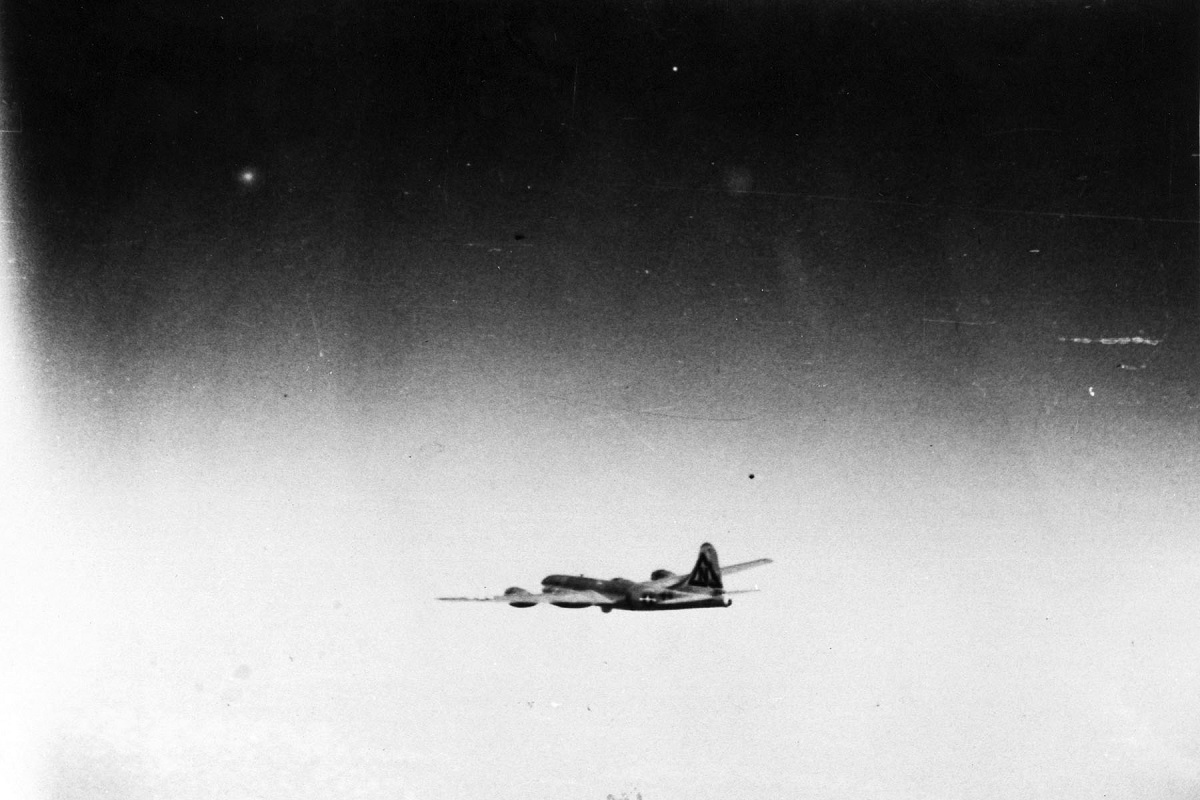Tibbets came over to us and said ‘there is a new bomb under construction and, if successful, it will shorten the war’
Tech. Sgt. Brandon Shapiro first published the following story under the title Atomic Exposure: USAAF Navigator Photographed First Nuclear Missions.
Russell Gackenbach, 93, was sitting on his floral-patterned sofa in a small one-bedroom apartment in Clearwater, Florida, looking through a photo album that had original photographs of some of the most iconic people and moments in American military history.
“This is me and Tibbets (Col. Paul Tibbets, pilot of the Enola Gay),” Gackenbach said, as he pointed to two U.S. Army Air Force officers standing next to one another. “This was me and Necessary Evil, the plane I flew on as we dropped the bomb on Hiroshima (Japan).”

Gackenbach connected name to face and story to picture as if it were yesterday. Even though it had been 70 years, the vivid details of his story and the sincere tone in his voice revealed how dearly held each of those people and occasions were to him.
Gackenbach was a second lieutenant who flew into the heart of Japan on August 6, 1945, where “Little Boy,” a 9,000-pound uranium-235 atomic bomb, was dropped on Hiroshima. He was also an aircraft navigator and photographer. The mission was the first time a nuclear weapon had been used in conflict, which was unknown to him at the time.
Before “The Bomb”
Gackenbach, a Pennsylvania native, joined the Bethlehem Steel Company in 1941 as an inspector of military bombs and shell casings after earning his high school degree from Allentown High School. Shortly after, Gackenbach, at 20 years old, made the decision to join the U.S. Army Air Corps in order to fulfill his childhood dream of becoming a pilot.
“I was originally classified for training as a pilot; however, during school, I was unable to conduct my solo flight in the allotted time and was eventually ‘washed out’ of the program,” said Gackenbach. “Then, I was sent to navigation school where I earned my wings and my commission.”
Gackenbach was sent to Wendover, Utah after obtaining his navigator certification and finishing the radar operators course in Boca Rotan, Florida. Young Gackenbach set off on an incredible voyage there, just seven months after getting his commission, that would alter the course of history.
“In September of ‘44, we were approached by an unfamiliar colonel who stressed that he was ‘forming an elite group that was to be made up from the best in the Air Corps,’” said Gackenbach. “The missions were to be dangerous and if anyone was not able to deal with the secrecy of the group, they may leave.”
Gackenbach accepted without hesitation, was interested in the chance, and was honored by the opportunity. Gackenbach and his crew saw Tibbets for the first time shortly after; it was at this point that they finally received a picture of what the mission would entail.
“Tibbets came over to us and said ‘there is a new bomb under construction and, if successful, it will shorten the war,’” recalled Gackenbach. “He was not able to tell us exactly what it was or any more details about it. He informed us that we were going to be under tight security, our movements would be limited, and we need to learn to keep our mouths shut.
“Before he left he pointed to a sign posted up on the outside of the gate, which read ‘what you see here when you leave here, let it stay here’ –and he meant that.”
Preparing for the unknown
The newly formed crews were working nonstop to switch from 15 mission-specific B-29 Superfortresses that had been equipped to carry the new atomic bombs to the B-17 Flying Fortress.
They tirelessly trained from Wendover Field from September 1944 to April 1945, before packing up their operation and moving to the Marianas island of Tinian in May.

The 4th Marine Division took possession of the island on August 1st, 1944, following a brutal campaign to reclaim it from 9,000 Japanese soldiers.
The 20th U.S. Army Air Force now called Tinian, Saipan, and Guam home after 15,000 Seabees constructed six 7,900-foot runways to accommodate the B-29.
“The transition to the Marianas put us about seven and a half hours away from Japan; although we were in a new location, we trained the exact same way had been doing in the states,” said Gackenbach. “Our only focus was to follow orders and polish our skillset for what we were told was to be a perfect mission.’”
The group practiced for almost a year, dropping inert test bombs made by the 216th AAF Base Unit, a special ordinance group, that they called “pumpkins.” In order to provide information on ballistics, electrical fusing and detonators, release mechanisms, and the impact on the flying characteristics of the aircraft, inert bombs were dropped by B-29s during training.
Missions of preparation continued up until August 5, 1945, the day before the first atomic bomb was dropped.
New weapon, new mission, new world
The crews assigned to the bombing mission were called in on August 5. Once there, they underwent a search and were instructed to empty their pockets before going to the briefing area. Only the information required for the flight—the route, the targets, and their specific job assignments—was provided at the briefing.
“We did not know what type of bomb we had; did not know what type of blast to expect; did not know the effect of it,” said Gackenbach. “The only thing we were told was, ‘don’t fly through the cloud.’”
The allocated crews gathered the following morning for a last-minute special mission brief; they worked out the details and quickly ate breakfast. The Enola Gay, the Great Artiste, and the Necessary Evil were three B-29s that departed for Japan’s southern coast at around three in the morning.

“As we approached Hiroshima on Aug. 6, 1945, the Enola Gay and The Great Artiste went forward, as we stayed behind and did a looping 360-degree turn,” recounted Gackenbach. “When we came out of the turn, the radios went dead; and when the radio went dead, we were alerted, ‘bomb bay doors open, bombs away.’”
In an effort to get as far away from the bomb as possible, the Enola Gay and The Great Artiste immediately performed diving spins to the right. The bomb detonated in front of Gackenbach and the Necessary Evil as they trailed the first two aircraft. Gackenbach held a camera up to his eye and pressed the shutter as a massive mushroom-shaped cloud boiled upward.

“The delay between our aircraft was planned; we were to document the event,” said Gackenbach. “The photographs seen around the world were ones I had taken approximately one minute after detonation, at a height of 30,000 feet, roughly 16 miles from the city.”
The aircrew was aware that this was no ordinary bombing operation from the first practice flights until they arrived over the target, but nothing could have prepared them for what they saw 47 seconds after the command of “bombs away.”
“We were awestruck; we didn’t know what to say, or do, or anything. We made three turns around the cloud and headed home to Tinian,” said Gackenbach. “I did not hear the word atomic until the next day.”
The crews didn’t realize the extent of the tragedy until days later, when Hiroshima photos were presented to them; only then did they fully comprehend the catastrophic impact of the weapon they had used.
“We never really talked about what we did—I stayed mute for a very long time. Even during our reunions, we only talked about each other and the time we spent together,” said Gackenbach.
On November 1, 1945, military planners set the date for Operation Olympic, the invasion of Kyushu, the home island of the Japanese. The invasion of Honshu, the largest island in Japan, would occur after it in 1946.
Given the remarkable American casualties in the struggle for Okinawa that spring—one-third of the invading force was killed, wounded, or missing—the U.S. government estimated that 1 million Americans would die and be injured in an assault on the Japanese home islands.
Instead, the August 9 atomic bomb missions of Hiroshima and Nagasaki ended World War II with Japan’s unconditional surrender on August 14, 1945.
“Looking back at the event 70 years later, I still believe the right decision was made and I think that President Truman knew that as well. Can you imagine if people found out we had a device that would save millions of lives and did not use it? He would have been in a peck of trouble,” Gackenbach said.
Gackenbach, the sole survivor of the first atomic attack, continues to this day to visit schools and cities, shaking hands and sharing his firsthand experience of one of the most pivotal events in American military history.
When asked if he would do things differently, he responds with a stoic: “I do not regret the part I played in it; it was the right decision.”

Photo by U.S. Air Force



